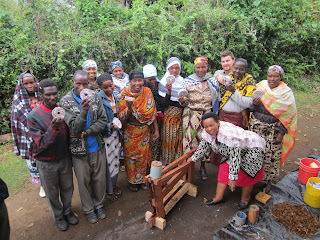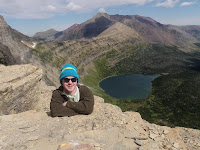On Monday we made our fourth visit to Nkoarisombu to check
on their progress after the briquetting training. We went primarily to answer
questions or to fix any problems that arose during the two weeks after the
training. The VICOBA members did not have any issues thus far and have been
working on their own compost piles at home. We also asked them about charcoal
sellers in the area, as we would like to look into making briquettes using
charcoal dust. The group does not have ready access to charcoal and they
primarily use wood, so we will continue emphasizing biomass composting. We will
meet with them again next week to take a look at their compost piles and give
them feedback.
A few weeks ago, we were getting out of a dala dala and met
a pastor named Sossy who worked in a town called Moivaro, close to Arusha. He
showed interest in our work and said that he would like for us to visit his
home before we left Tanzania. After our visit to Nkoarisombu on Monday, we
headed over to Moivaro to visit Sossy and see his workplace. Sossy works at
Moivaro Tumaini (“Hope”) School, a non-governmental school dedicated to
providing a good education to children from impoverished families. Sossy
described his frustration with government schools, many of which have one
teacher for 300 students. Sossy wants to lower this student to teacher ratio in
his school, aiming to have 5-6 teachers educate around 150 students. Currently,
his school has 2 teachers with salaries larger than what Sossy can pay them.
Most of the children’s parents cannot pay more than $1 for their child’s
education, so the school is struggling to obtain funding to complete
construction. Sossy relies on volunteer
groups and donations to continue construction of the school.
The school's two classrooms
Nik and Sossy in front of the multipurpose building
As his wife sat us down for coffee, Sossy explained the
issues with cooking meals for the children. Charcoal is readily available to
the area, but it costs around 4,000-5,000 TSH every 2-3 days. This fuel cost is
very high, but Sossy and his wife have not been able to find cheaper options
cleaner than wood. We talked to them about our briquetting and stoves projects,
and Sossy and his wife were very
interested in both technologies. They asked us to teach them and the surrounding
community about briquetting, so they might be able to save money and possibly create
revenue for the school. We eventually decided that if we provided a training program, Sossy would gather interested
members from the community to learn about briquetting and create their own program. We plan on
having the training next week and will adopt a program similar to what we
taught Nkoarisombu.
Inside a classroom
In front of the gate to the school
Our briquetting project goal for the upcoming week is to create a
poster highlighting the most important aspects of briquetting, which we will
use in training programs and plan on giving to EARD-CI so they may continue briquetting
training programs after DHE has left Tanzania. We look forward to teaching more
communities about briquetting, so they may cut down on fuel costs and even
generate a source of income.
























.jpg)